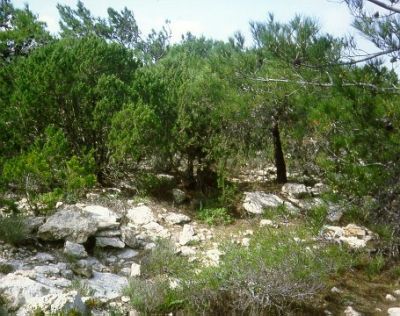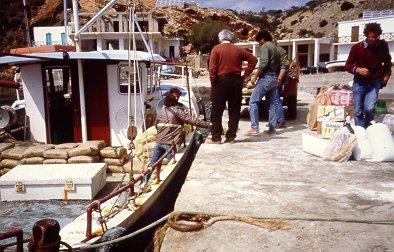|
Gavdos Island
Area: 27 sq. km
 Gavdos
island, is opposite of Sfakia, is the southern most border of
Greece and Europe. It is 24 nautical miles away from Agia
Roumeli, right in the middle of the Libyan Sea. If you climb
up any of the southern peaks of the White Mountains of Crete,
on a clear day, you will see the island of Gavdos lying flat
on the horizon amidst the Libyan Sea. Gavdos
island, is opposite of Sfakia, is the southern most border of
Greece and Europe. It is 24 nautical miles away from Agia
Roumeli, right in the middle of the Libyan Sea. If you climb
up any of the southern peaks of the White Mountains of Crete,
on a clear day, you will see the island of Gavdos lying flat
on the horizon amidst the Libyan Sea.
Gavdos is
the southernmost tip of Greece and consequently of Europe. It
is a low, sandy island wooded with pine trees and cedars. Of
its 5 old villages 3 are still inhabited. Two new settlements
grew in recent years. The first at the port, the Karave, and
the second at the bay of Sarakiniko. Altogether the
inhabitants of Gavdos today do not exceed 40 people. In the
summer there is an influx of racksacks tourists, mostly
germans and austrians, who freelance camp at the Sarakiniko
bay.
The word you
hear most on the island is the word "destruction",
or "Zerstoerung" in german, or "anaptixi"
in greek. Ironically, the greek word means
"developement", but for the Gavdiotes,
"anaptixi" was the irrevesible abandoning of
traditional peasant life, and the building of numerous illegal
dwellings such as tavernas and rooms to let, at the island's
most beatiful areas, promoting the destruction of the delicate
ecosystem, and of the archeological remains.
 According to
Callimachus, this is the ancient isle of Ogygia where, as
Homer claims in "Odyssey", the nymph Calypso lived.
Other names of Gavdos in the past were "Cavdos" and
"Clavdos" (Ptolemens and Ierocles),
"Glavdi" (the Epistles), "Gozzo" (the
Venetians) and "Bougadoz" (the Turks). In the first
Byzantine period, Gavdos had a bishop, as it had many
inhabitants, but, during the Venetian Rule, the islet was
abandoned, as pirates sought refuge there. Until the late
18th, early 19th century, Gavdos belonged to Sfakia and was
part of the Municipality of Anopolis Sfakion. According to
Callimachus, this is the ancient isle of Ogygia where, as
Homer claims in "Odyssey", the nymph Calypso lived.
Other names of Gavdos in the past were "Cavdos" and
"Clavdos" (Ptolemens and Ierocles),
"Glavdi" (the Epistles), "Gozzo" (the
Venetians) and "Bougadoz" (the Turks). In the first
Byzantine period, Gavdos had a bishop, as it had many
inhabitants, but, during the Venetian Rule, the islet was
abandoned, as pirates sought refuge there. Until the late
18th, early 19th century, Gavdos belonged to Sfakia and was
part of the Municipality of Anopolis Sfakion.
The island
had a roman era city, traces of which are still to be seen at
the north west of the island. The ancient city was succeded by
a byzantine town, which was situated on the hill of Agios
Ioannis at the north of the island. The byzantine town must
have been of a considerable size, since it had 8000
inhabitants, and even its own archbishop. In later times the
island should have been desolated and the nest of pirates. The
names of two bays on the island, that carry the name of
Sarakiniko and Sarakinou, is all what reaches us today from
this dark period of history. |